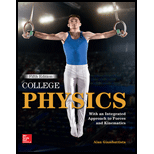
(a)
The velocity of the satellite at the point C.
(a)
Answer to Problem 90P
The velocity of the satellite at the point C is
Explanation of Solution
Write the expression for velocity of the satellite.
Here,
Conclusion:
Substitute
Therefore, the velocity of the satellite at the point C is
(b)
The average velocity of the satellite for one quarter of an orbit starts at point A to the end point B.
(b)
Answer to Problem 90P
The average velocity of the satellite for one quarter of an orbit starts at point A to the end point B is
Explanation of Solution
Write the expression for average velocity of the satellite.
Here,
Substitute
Conclusion:
Substitute
Therefore, the angle does the wheel rotate during the third
(c)
The average acceleration of the satellite for one quarter of an orbit starts at point A to the end point B.
(c)
Answer to Problem 90P
The average acceleration of the satellite for one quarter of an orbit starts at point A to the end point B is
Explanation of Solution
Write the expression for average acceleration of the satellite.
Here,
Since, the average acceleration is in the same direction as,
Substitute
Conclusion:
Substitute
Therefore, the average acceleration of the satellite for one quarter of an orbit starts at point A to the end point B is
(d)
The acceleration of the satellite at point D.
(d)
Answer to Problem 90P
The acceleration of the satellite at point D is
Explanation of Solution
Write the expression for gravitational force.
Here,
Write the expression from Newton’s second law.
Here,
Conclusion:
Solve the equation (IV) and (V) to find centripetal acceleration.
Substitute
Therefore, the acceleration of the satellite at point D is
Want to see more full solutions like this?
Chapter 5 Solutions
College Physics
 College PhysicsPhysicsISBN:9781305952300Author:Raymond A. Serway, Chris VuillePublisher:Cengage Learning
College PhysicsPhysicsISBN:9781305952300Author:Raymond A. Serway, Chris VuillePublisher:Cengage Learning University Physics (14th Edition)PhysicsISBN:9780133969290Author:Hugh D. Young, Roger A. FreedmanPublisher:PEARSON
University Physics (14th Edition)PhysicsISBN:9780133969290Author:Hugh D. Young, Roger A. FreedmanPublisher:PEARSON Introduction To Quantum MechanicsPhysicsISBN:9781107189638Author:Griffiths, David J., Schroeter, Darrell F.Publisher:Cambridge University Press
Introduction To Quantum MechanicsPhysicsISBN:9781107189638Author:Griffiths, David J., Schroeter, Darrell F.Publisher:Cambridge University Press Physics for Scientists and EngineersPhysicsISBN:9781337553278Author:Raymond A. Serway, John W. JewettPublisher:Cengage Learning
Physics for Scientists and EngineersPhysicsISBN:9781337553278Author:Raymond A. Serway, John W. JewettPublisher:Cengage Learning Lecture- Tutorials for Introductory AstronomyPhysicsISBN:9780321820464Author:Edward E. Prather, Tim P. Slater, Jeff P. Adams, Gina BrissendenPublisher:Addison-Wesley
Lecture- Tutorials for Introductory AstronomyPhysicsISBN:9780321820464Author:Edward E. Prather, Tim P. Slater, Jeff P. Adams, Gina BrissendenPublisher:Addison-Wesley College Physics: A Strategic Approach (4th Editio...PhysicsISBN:9780134609034Author:Randall D. Knight (Professor Emeritus), Brian Jones, Stuart FieldPublisher:PEARSON
College Physics: A Strategic Approach (4th Editio...PhysicsISBN:9780134609034Author:Randall D. Knight (Professor Emeritus), Brian Jones, Stuart FieldPublisher:PEARSON





